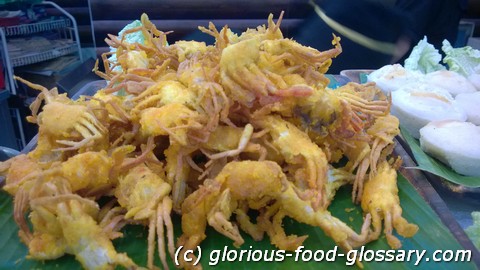English: Breaded Talangka / Deutsch: panierte Talangka / Español: Talangka empanado / Português: Talangka empanado / Français: Talangka pané / Italiano: Talangka impanato /
"Breaded Talangka" refers to a Filipino culinary dish involving talangka, which are small crabs, known in English as Asian shore crabs or river crabs. These crabs are notable for their flavorful meat and roe. In this dish, the talangka are typically cleaned, coated in a breadcrumb mixture, and then deep-fried until golden and crispy. This preparation enhances the natural flavors of the crabs and adds a crunchy texture to the exterior, making it a beloved delicacy.
Culinary Uses:
The process involves several steps:
- Preparation: The talangka are thoroughly cleaned, and in some recipes, they may be lightly seasoned before being coated.
- Breading: The crabs are dipped in beaten eggs and then coated with breadcrumbs. Some variations might include flour or cornstarch in the breading mixture for extra crispiness.
- Deep-Frying: The breaded crabs are deep-fried in hot oil until they achieve a golden-brown crust. The high heat cooks the crabs quickly, sealing in their flavor.
Serving Suggestions:
Breaded talangka can be served as an Appetizer or a main dish, often accompanied by a dipping sauce, such as vinegar with garlic, spicy mayo, or a sweet and sour sauce, to Complement the rich flavors of the crabs.
Nutritional Value:
Talangka are rich in protein and offer a good amount of omega-3 fatty acids, vitamins, and minerals, although they should be consumed in moderation due to their cholesterol content. The deep-frying process does add fat, making this dish more indulgent.
Cultural Significance:
Seafood plays a significant role in Filipino cuisine, given the country's extensive coastline and rich marine biodiversity. Talangka, being readily available in local markets, is utilized in various traditional dishes, showcasing the Filipino knack for turning simple ingredients into flavorful meals.
Summary
Breaded talangka is a testament to the simplicity and richness of Filipino culinary traditions, offering a crispy, flavorful experience that highlights the unique taste of these small crabs. This dish exemplifies the innovative use of local seafood in creating delightful, satisfying meals.
--
Breaded Talangka refers to a dish made from Talangka (tiny River Crabs) which is dip in batter then deep-fried in boiling oil. The dish is always served with Sawsawan (dip) made of Vinegar mixed with chopped garlic, and Siling Labuyo and salt and pepper to taste. Talangka is not always available , but by season

Related Articles to the term 'Breaded Talangka' | |
| 'Talangka' | ■■■■■■■■■■ |
| Talangka a very small variety of crabs found in the Philippines. Its common English name is Asian shore . . . Read More | |
| 'Buchi' | ■■■■■■■■ |
| In the food context, \'Buchi\' is a popular Filipino dessert made from glutinous rice flour filled with . . . Read More | |
| 'Pakoras' | ■■■■■■■■ |
| Pakoras in the food context refer to a popular South Asian snack made by dipping vegetables, meat, or . . . Read More | |
| 'Lumpiang Shanghai' | ■■■■■■■ |
| Lumpiang Shanghai in the food context refers to a popular Filipino dish consisting of thin, spring roll . . . Read More | |
| 'Pritong Daing na Bangus' | ■■■■■■■ |
| Pritong Daing na Bangus is a popular Filipino dish consisting of marinated and fried milkfish (Bangus). . . . Read More | |
| 'Fried Chicken' | ■■■■■■■ |
| Fried Chicken in the food context refers to a dish consisting of chicken pieces that have been coated . . . Read More | |
| 'Breading' | ■■■■■■■ |
| Breading in the food context refers to the process of coating food, typically meat, Fish, or vegetables, . . . Read More | |
| 'Pako' | ■■■■■■ |
| Pako, also known as fiddlehead fern, is a unique and nutritious vegetable that has gained popularity . . . Read More | |
| 'Bihod' | ■■■■■■ |
| Bihod is a Filipino or Ilonggo word which means fish roe . . . . . . Read More | |
| 'Bibingka' | ■■■■■■ |
| Bibingka is a delectable Filipino rice cake that holds a special place in Filipino cuisine and culture. . . . Read More | |
